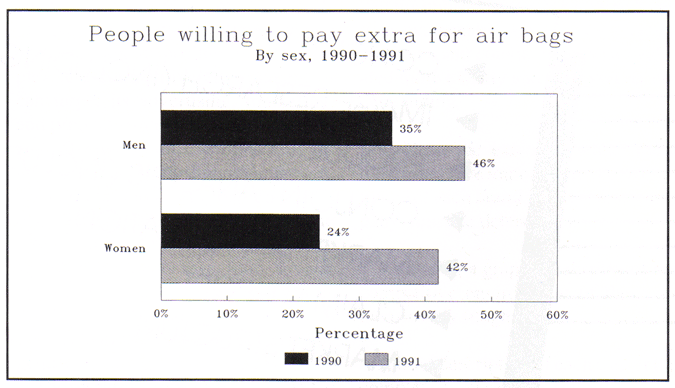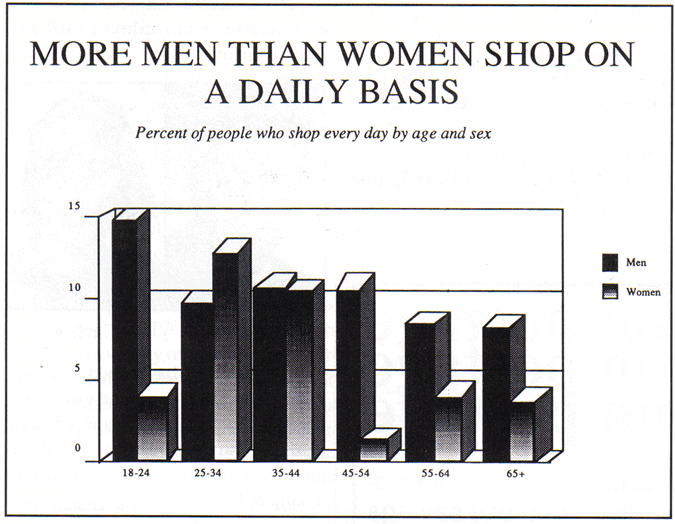Air bags are accepted despite lingering questions
Consumer awareness and acceptance of air bags in automobiles has increased significantly over the past few years, yet many Americans remain nervous about their technological safety, according to a nationwide survey on auto safety in America. The survey, conducted for Prevention magazine and General Motors by Louis Harris and Associates, found that 44 percent of American adults would pay an extra $500 for a car equipped with an air bag, compared to only 29% in 1990.
However, despite their willingness to pay more for the safety device, a large number of Americans questions, 38%, think that accidental air bag inflation is a serious problem. A significant proportion of consumers (35%) also believe that air bags can trap an individual in his or her car when inflated. In addition, while two-thirds of adults believe air bags provide better protection in a crash than seat belts alone, twenty percent of individuals mistakenly think air bags will take the place of seat belts.

"Despite the enormous efforts to educate consumers about the safety of air bags, and the key role these devices can play in saving lives, many individuals still perceive them as dangerous," says Richard Porter, publisher of Prevention. "The proven safety value of air bags must be reinforced with the consumer."
The survey found that consumers have responded to the use of other safety measures in cars such as wearing seat belts. According to the study, sixty-five percent of adults now say they always buckle up in the front seat of a car, up 46 points over 1984, when just 19 percent said they always wore seat belts.
Americans are also strongly in favor of laws mandating seat belt usage. Of those adults questioned, four out of five (80%) support mandatory seatbeltlaws, including 68% of those living in states without such laws.
Popularity of athletic shoes keeps rising
Almost three out of four Americans aged 13-75 (72 percent) bought athletic footwear in 1991, compared to 67 percent in 1988, according to a new national survey conducted by the Athletic Footwear Association (AFA). The percent of the population that wear athletic footwear declined over the same period from 87 to 84 percent, the survey found.
The popularity of athletic footwear, however, continued to climb among those who wear them:
- The average number of pairs owned by wearers rose from 2.7 in 1988 to 2.9 in 1991.
- The percent of wearers who own four or more pairs climbed from 20 to 25 percent over the 1988-1991 period.
- The average amount wearers said they spent for their last pair of athletic footwear rose from $30.10 to $42.60.
- The most wearers said they would be willing to spend climbed from $42.00 to $61.10.
"Perhaps the most dramatic changes involve prices people said they paid and were willing to pay," says Gregg Hartley, executive director of the North Palm Beach, Florida-based AFA. "Respondents from every segment we've broken out so far said they paid more in 1991 than 1988 and are willing to pay even more.
"We interpret this as evidence that footwear manufacturers have been extremely successful in increasing the value of their products. They've done this by offering technological, structural and design improvements and by successfully meeting fashion and lifestyle needs," Hartley says.
Total retail sales of athletic footwear in 1988 were $9.7 billion on 377 million pairs, according to the Sporting Goods Manufacturers Association (SGMA). The SGMA estimates that 1991 figures will be $12.4 billion on 395 million pairs.
Among other findings:
- Teenagers (ages 13-17) are the most enthusiastic buyers of athletic foot-wear. Ninety-five percent of all teens wear sneakers and 97 percent of that group bought a pair in the last year. Thirty-one percent of teen wearers own more than four pairs. This group spent $54.20 for the last pair and is willing to go as high as $76.10.
- The adult market declined in terms of percent of total population wearing athletic footwear, from 87 percent in 1988 to 81 percent in 1991. But the percent of adults who bought shoes in the past year increased, as did the percentage owning four or more pair (from 18 to 24 percent of wearers) and the amount spent for the last pair (from $29.80 to $40.20).
- Among blacks aged 13-75, 79 percent wore athletic footwear in 1991 and 75 percent of that number bought a pair in the past year. Thirty-three percent of black wearers own four or more pair and they are willing to spend about as much per pair as are teenage wearers ($76.20).
Survey profiles shopping habits
Shopping in America ranges from stopping for bread on the way home to buying a new car. Nearly half (46%) of Americans go shopping more than once a week, according to results from a national telephone survey conducted by Maritz Marketing Research, Inc. Almost two of ten Americans (18%) shop every day or every other day, while 27% shop two or three times each week.
For almost all ages, men shop on a daily basis more often than women. One-fourth of men 18-34 years old shop daily, compared to 17% of women. Similarly, 39% of men 35 or older, and just 20% of women, shop every day. "A possible reason," suggests Beth Nieman, research manager at Maritz, "is that men make shorter, fill-in trips like going to the store for milk, while women consolidate their shopping into longer, less frequent trips."
The average amount of weekly house-hold shopping expenditures, as estimated by 37% of Americans, ranges between $5 and $100. Just over one-quarter (26%) spend between $ 101 and $200, while 10% pay $201-$400. Only 4% of households spend over $400 weekly.
Weekly household expenditures as estimated by men are significantly higher than women's estimates. Men believe the household spends an average of $ 192 per week, while women say it's only $153.
Who's responsible for spending all that money? Significantly more women say they spend all or most of it than men (65% compared to 32%). Five percent of men don't spend any money on household shopping. Women still do the majority of grocery shopping (78%). But, according to one-third of men, they do all or most of the shopping for household food. This number declines as family size increases. Eighty-two percent of men in one-person households handle the majority of food shopping, as do 85% of women. But, in households of two persons, the number of men drops to 30%; and in families of four or more, it shrinks to 18%.
Overall, 69% of men say they do all or most of the shopping for their clothes and personal care items. Marriage significantly affects this number. Eighty-one percent of unmarried men do the majority of their own shopping, compared to 61% of married men. Conversely, the number of women who shop for the majority of their own clothes and personal care items increases after marriage from 89% to 95%.
Women make up a large segment of the market for durable goods. Forty-one percent say they do all most of the shopping for major purchases like appliances, furniture or cars. Interestingly, older women are more likely than younger women to handle this type of shopping. Fifty-one percent of females 45 or older do the majority of such shopping, compared to 31% under the age of 45.
More main meals include a microwaved item
As a part of its National Eating Trends Service, The NPD Group, Inc., Port Washington, New York, tracked microwave usage habits among the 2,000 households that participate in the panel. Results from the study were reported reported in a recent issue of the company's newsletter, NPD Insights. Some highlights include:
- In 1990, 20% of all main meals included a microwaved item, up from 6% in 1984.
- Americans are not microwaving more often than they did in 1984. Growth has stemmed from new users rather than frequency of use.
- Singles in 1990 now consume more microwaved food and beverages than families.
- Microwave items having the greatest growth since 1984 are: microwave popcorn, poultry, frozen vegetables, soup.
- Leftovers are not as important to microwave use as one might expect. Only 20% of all microwaved items were leftover dishes in 1990, the same as 1984.
